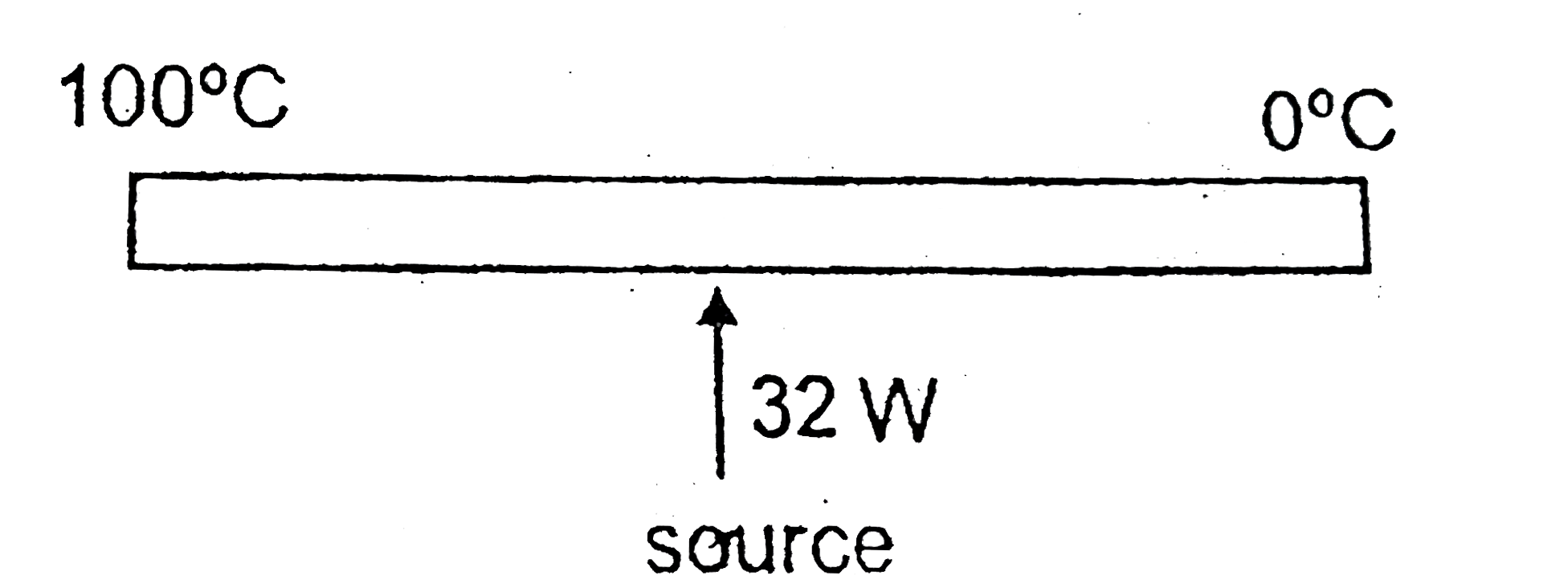A heat flux of 4000 J/s is to be passed through a copper rod of length 10 cm and area of cross-section 100 cm. sq. The thermal conductivity of copper is 400 W/mC. The two ends of this rod must be kept at a temperature difference of-
1∘C
10∘C
100∘C
1000∘C
The correct Answer is:C
To solve the problem, we need to find the temperature difference (ΔT) required to maintain a heat flux of 4000 J/s through a copper rod. We can use the formula for heat conduction, which is given by Fourier's law:
Q=k⋅A⋅ΔTL
Where:
- Q is the heat transfer per unit time (in watts, W),
- k is the thermal conductivity of the material (in W/m°C),
- A is the cross-sectional area (in m²),
- ΔT is the temperature difference across the rod (in °C or K),
- L is the length of the rod (in meters).
1. Convert the given values to SI units:
- Length of the rod, L=10cm=0.1m
- Area of cross-section, A=100cm2=100×10−4m2=0.01m2
- Heat flux, Q=4000J/s=4000W (since 1 J/s = 1 W)
- Thermal conductivity of copper, k=400W/m°C
2. Rearranging the formula to solve for ΔT:
ΔT=Q⋅Lk⋅A
3. Substituting the values into the equation:
ΔT=4000W⋅0.1m400W/m°C⋅0.01m2
4. Calculating the denominator:
k⋅A=400W/m°C⋅0.01m2=4W/°C
5. Calculating ΔT:
ΔT=4000⋅0.14=4004=100°C
Final Answer:
The temperature difference (ΔT) required across the copper rod is 100°C.
- Q is the heat transfer per unit time (in watts, W),
- k is the thermal conductivity of the material (in W/m°C),
- A is the cross-sectional area (in m²),
- ΔT is the temperature difference across the rod (in °C or K),
- L is the length of the rod (in meters).
- Length of the rod, L=10cm=0.1m
- Area of cross-section, A=100cm2=100×10−4m2=0.01m2
- Heat flux, Q=4000J/s=4000W (since 1 J/s = 1 W)
- Thermal conductivity of copper, k=400W/m°C
ΔT=Q⋅Lk⋅A
ΔT=4000W⋅0.1m400W/m°C⋅0.01m2
k⋅A=400W/m°C⋅0.01m2=4W/°C
ΔT=4000⋅0.14=4004=100°C
The temperature difference (ΔT) required across the copper rod is 100°C.
Topper's Solved these Questions
- THERMAL PROPERTIES OF MATTER Book:PHYSICS WALLAHChapter:THERMAL PROPERTIES OF MATTER Exercise:NEET Past 5 Years Questions
Explore 12 Videos
- THERMAL PROPERTIES OF MATTER Book:PHYSICS WALLAHChapter:THERMAL PROPERTIES OF MATTER Exercise:NEET Past 5 Years Questions
Explore 12 Videos
- SYSTEM OF PARTICLES AND ROTATIONAL MOTION Book:PHYSICS WALLAHChapter:SYSTEM OF PARTICLES AND ROTATIONAL MOTION Exercise:NEET PAST 5 YEARS QUESTIONS
Explore 22 Videos
- THERMODYNAMICSBook:PHYSICS WALLAHChapter:THERMODYNAMICSExercise:NEET Past 5 Years Questions
Explore 14 Videos
Similar Questions
Calculate the thermal resistance of an aluminium rod of length 20cm and area of cross-section 4cm2. The thermal conductivity of aluminium is 210Js−1m−1K−1.
View SolutionThe ends of a copper rod of length 1m and area of cross-section 1cm2 are maintained at 0∘C and 100∘C. At the centre of the rod there is a source of heat of power 25 W. Calculate the temperature gradient in the two halves of the rod in steady state. Thermal conductivity of copper is 400Wm−1K−1.
View Solution
Knowledge Check
A heat flux of 4000 J/s is to be passed through a copper rod of length 10 cm and area of cross section 100cm2. The thermal conductivity of copper is 400W/m/∘C The two ends of this rod must be kept at a temperature difference of
A1∘CB10∘CC100∘CD1000∘CThe heat is flowing through a rod of length 50 cm and area of cross-section 5cm2 . Its ends are respectively at 25∘C and 125∘C . The coefficient of thermal conductivity of the material of the rod is 0.092kcal/m×s×.∘C . The temperature gradient in the rod is
A2∘C/cmB2∘C/mC20∘C/mD20∘C/cmThe ends of copper rod of length 1m and area of cross section 1cm2 are maintained at 0∘C and 100∘C. At the centre of rod, there is a source of heat of 32W. The thermal conductivity of copper is 400W/mK
 AThe temperature of rod at centre is 250∘CBThe temperature of rod at centre is 50∘CCThe temperature gradient in right half is 500∘C/mDThe temperature gradient in left half is 300∘C/m
AThe temperature of rod at centre is 250∘CBThe temperature of rod at centre is 50∘CCThe temperature gradient in right half is 500∘C/mDThe temperature gradient in left half is 300∘C/m
Heat is flowing through a rod of length 25.0cm having cross-sectional area 8.80cm2. The coefficient of thermal conductivity for the material of the rod is K=9.2×10−2kcals−1m−1.∘C−1. The Temperatures of the ends of the rod are 125∘C and 0∘C in the steady state. Calculate (i) temeprature gradient in the rod (ii) temperature of a point at a distance of 10.0cm from the hot end and (iii) rate of flow of heat.
View SolutionTwo bodies each of mass m, having specific heats s, are connected by ametal rod of negligible heat capacity of length l, area of cross section A and thermal conductivity k. Initially both bodies are at different temperatures, find the time taken for the temperature difference between the two bodies to become half of the. initial value.
View SolutionA rod of negligible heat capacity has length 40cm, area of cross-section 1.0cm2 and thermal conductivity 100Wm−1∘ C−1. The temperature of one end is maintained at 0o C and that of the other end is slowly and linearly varied 'from 0∘C to 60∘C in 10min. Assuming no loss of heat through the sides', find the total heat transmitted (in J) through the rod in these 10min.
View SolutionOne end of a copper rod of length 1 m and area of cross - section 400×(10−4)m2 is maintained at 100∘C. At the other end of the rod ice is kept at 0∘C. Neglecting the loss of heat from the surrounding, find the mass of ice melted in 1h. Given, KCu=401W/m−KandLf=3.35×(105)J/kg.
View SolutionOne end of a metal rod of length 1.0 m and area of cross section 100cm2 is maintained at . 100∘C. If the other end of the rod is maintained at 0∘C , the quantity of heat transmitted through the rod per minute is (Coefficient of thermal conductivity of material of rod =100W/m−K)
View Solution

